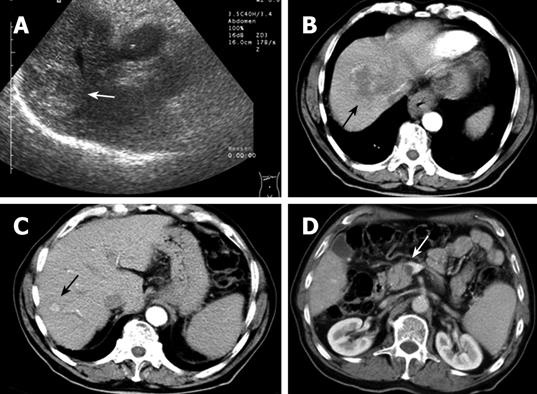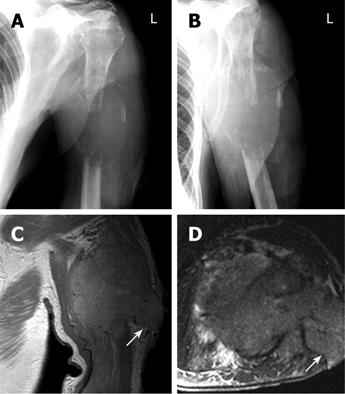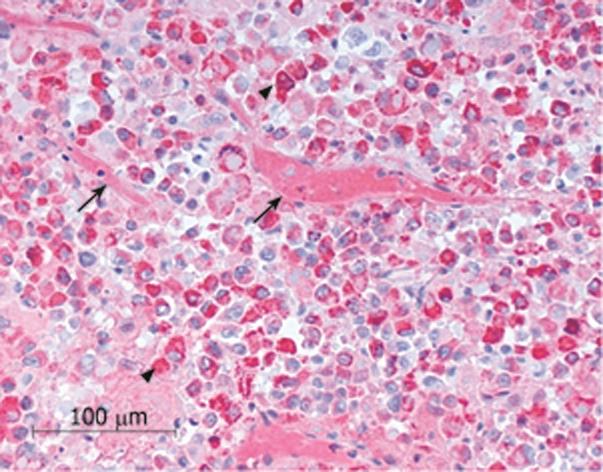Copyright
©2009 The WJG Press and Baishideng.
World J Gastroenterol. May 14, 2009; 15(18): 2280-2282
Published online May 14, 2009. doi: 10.3748/wjg.15.2280
Published online May 14, 2009. doi: 10.3748/wjg.15.2280
Figure 1 Liver sonography (A) and CT imaging of hepatocellular carcinoma (HCC) (B-D).
A: Round but inhomogeneous tumor with hyper- and hypo-echoic appearance in the sonography (diameter 6 cm, arrow); B: Axial multidetector CT contrast image at the arterial phase demonstrated a tumor lesion in the right upper lobe (arrow). Dimension 7 cm × 6.5 cm × 60 cm with hyperdense periphery and hypodense centre (latter areas of necrosis); C: Additional 1.4 cm × 1 cm × 1 cm hyperintense lesion in segment VII of the liver (arrow); D: Partial thrombosis of the portal vein (arrow).
Figure 2 X-Ray (A, B) and MR imaging (C, D) of HCC metastasis at the humerus.
A and B: Destructive lesion in the left humerus associated with a bulging soft tissue component, 5.5 cm × 4 cm in dimension; C: Coronal noncontrast PD-weighted (TR/TE, 1920/12) image demonstrating a soft tissue tumor (coronal dimension 6.2 cm × 5 cm) with complete destruction of the humerus, the tumor reached the surface with ulceration (arrow); D: Axial noncontrast TIRM sequences (TR/TE, 7400/92) show the edematous tumor in the centre of the extremity and the lateral tumor branch to the surface (arrow). In this region, a biopsy was taken which was followed by massive hemorrhage.
Figure 3 Catheter angiography of the tumor before (A, B) and after embolization (C), X-Ray after final treatment with amputation of the left upper extremity (D).
A: Catheter angiography of the axillary artery reveal a round hypervascular tumor; B: Selective angiography of a tumor feeding vessel as side of application of Bead Block (size 300-500 &mgr;m, Terumo Europe, Leuven, Belgium) for embolization; C: After embolization of main parts of the tumor, at this status no areas of bleeding detectable but small parts of the tumor still perfused; D: Final treatment with amputation of the left upper extremity.
Figure 4 Neoplastic cells of HCC metastasis were diffusely stained by hepatocellular antigen (for instances, see arrowheads), destroyed bone areas within the tumor are visible (arrows).
- Citation: Hansch A, Neumann R, Pfeil A, Marintchev I, Pfleiderer S, Gajda M, Kaiser WA. Embolization of an unusual metastatic site of hepatocellular carcinoma in the humerus. World J Gastroenterol 2009; 15(18): 2280-2282
- URL: https://www.wjgnet.com/1007-9327/full/v15/i18/2280.htm
- DOI: https://dx.doi.org/10.3748/wjg.15.2280












